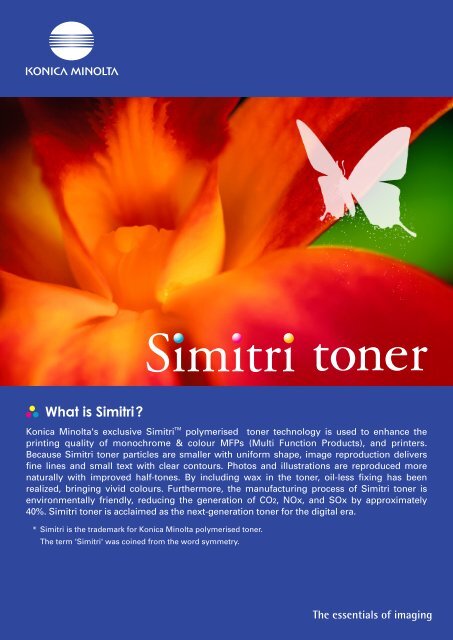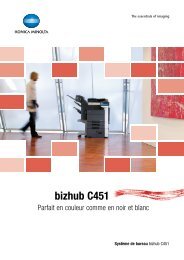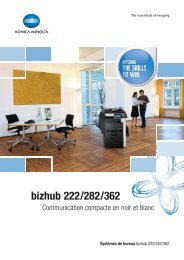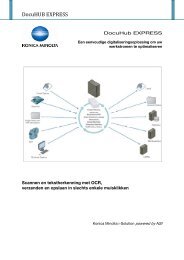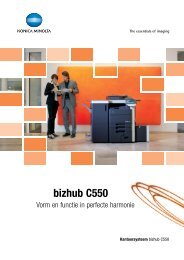Simitri Polymerised Toner (Pdf)
Simitri Polymerised Toner (Pdf)
Simitri Polymerised Toner (Pdf)
- No tags were found...
Create successful ePaper yourself
Turn your PDF publications into a flip-book with our unique Google optimized e-Paper software.
What is <strong>Simitri</strong>?Konica Minolta's exclusive <strong>Simitri</strong> TMpolymerised toner technology is used to enhance theprinting quality of monochrome & colour MFPs (Multi Function Products), and printers.Because <strong>Simitri</strong> toner particles are smaller with uniform shape, image reproduction deliversfine lines and small text with clear contours. Photos and illustrations are reproduced morenaturally with improved half-tones. By including wax in the toner, oil-less fixing has beenrealized, bringing vivid colours. Furthermore, the manufacturing process of <strong>Simitri</strong> toner isenvironmentally friendly, reducing the generation of CO2, NOx, and SOx by approximately40%. <strong>Simitri</strong> toner is acclaimed as the next-generation toner for the digital era.* <strong>Simitri</strong> is the trademark for Konica Minolta polymerised toner.The term '<strong>Simitri</strong>' was coined from the word symmetry.
Superb image qualitySuperb image qualityWith <strong>Simitri</strong> toner, fine lines and small text are clearly reproduced, and photos and illustrationshave smoother gradation of half tones. Due to the particles being small and of uniform shape,<strong>Simitri</strong> toner reproduces text without jagged contours, and produces prints with brilliantsharpness. Its quality is most noticeable when making generation copies. Vivid colours closeto that of the original silver-halide photo prints are obtained.Image quality comparison<strong>Simitri</strong> toner Conventional toner <strong>Simitri</strong> toner Conventional toner<strong>Simitri</strong> tonerConventional toner1
Superb image qualityWider gamut* 1Clear and vivid colour reproduction is achieved, conforming to the JAPAN COLOR*©˜ 2 standardwhich has a wide gamut.Colour rangeblue b yellowColour reproduction comparison<strong>Simitri</strong> tonerJAPAN COLOR with normal paperJAPAN COLOR with glossy papergreen a red*1Gamut means a specified range of colour. It also determines a colour range where specified input/outputdevices such as monitors and printers can display and print within, respectively. The gamut that ordinarymonitors can reproduce is argued to be smaller than that recognized by the human eye. The gamutreproduced by process-printing ink is even smaller than that of the monitor.*2 JAPAN COLOR standard has been established to unify the offset printing colours in Japan. Similar standardscan be found in USA (SWOP), and in Europe (Euro Standard).Light-resistantWith normal commercial printing ultraviolet rays sometimes fade yellow colours. Prints using<strong>Simitri</strong> toner, however, are resistant to these ultraviolet rays and therefore colour quality ispreserved.*Simulated effects of sustained ultraviolet ray irradiation equal to several years' period.(Based on tests carried out by Konica Minolta)2
Oil-less fixingOil-less fixingBy including wax in the toner manufacturing, oil-less fixing has been realized. This makes itunnecessary to apply silicon oil to the heater during the fixing process, thus eliminating the"white-line noise" that is caused by dust adhered to the optical system by the vapour from theoil. And, as image glare that is usually caused by oil is eliminated, you get clean imageswithout blur and oily stains. This means you can also use ballpoint pens to write on the prints,or put labels on them. Furthermore, as there is no need to refill oil, the life of the fixing unit isprolonged, which enhances machine reliability and facilitates maintenance.*Konica Minolta adopts a special polymerisation method in which wax is dissolved in the monomer (the rawmaterial of the resin), then, emulsified and dispersed into water (aqueous solution) to create particles. Thiscohesion and fusion of particles and colour pigments make it possible to contain a large amount of waxevenly, realizing a polymerised toner that enables oil-less fixing.3
Low-temperature fixingLow-temperature fixingBy making the particles smaller and uniform in shape, toner fixing can be achieved at a muchlower temperature, preventing paper curling or jamming during the finishing process. Lesspaper curl means thinner binding of prints to be stapled or stitched, even in large quantitiesregardless of thickness.During the fixing process that requires a higher fixing temperature, thick paper absorbs heat,thereby, lowering the fixing temperature. When fixing can occur at a lower fixing temperaturethe process is not degraded, thus, allowing you to use a wider range of paper thickness. Eventhin paper that would normally wrinkle very quickly is far less likely to suffer these effectsbecause the fixing pressure can be lowered.4
Environmentally friendlyEnvironmentally friendlyCompared to the conventional pulverized toners, manufacturing of <strong>Simitri</strong> toner requires lessenergy, and contributes to environmental preservation, reducing by 40%, the generation ofCO2, NOx or SOx that cause greenhouse gases, and acid rain.5
How <strong>Simitri</strong> toner is producedHow <strong>Simitri</strong> toner is producedIn the polymerisation method, minute resin particles in approximately 100 Nanometer(1/10.000th of 1 mm) are synthesized by emulsification, and then chemically condensed andfused with colour pigments. The merit of this method is the easy production of smaller andmore uniformly shaped particles for the polymerised toner.6


